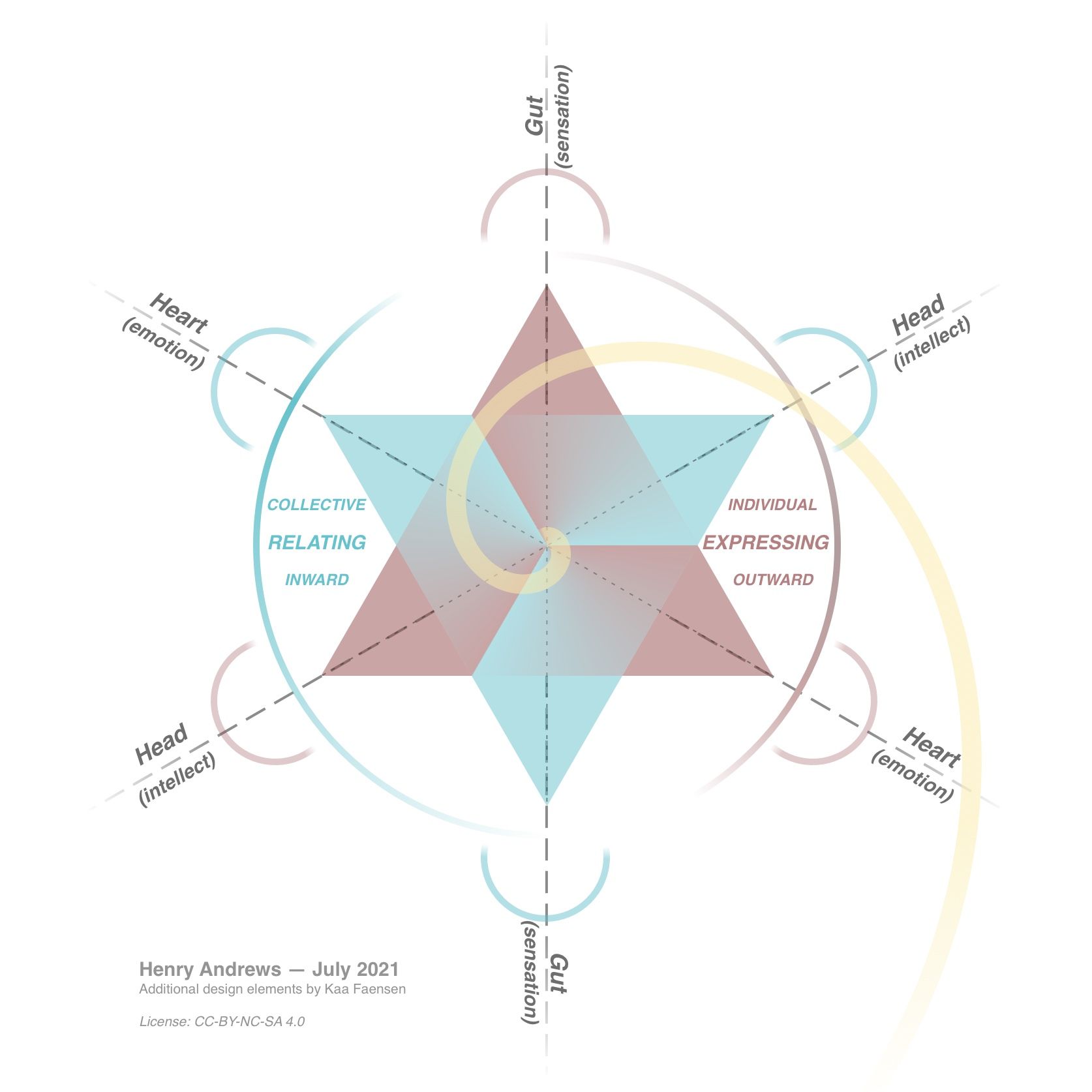Diagrams

This is where I will upload and explain the basics of my diagrams, the meaning of the geometry, the rationales behind various word choices, and the variations used in different theoretical and applied situations. I will update this page very frequently at first as it will take a while to get all of the material up here, and I don't want to wait for a perfect complete page. I will occasionally make posts about important updates in order to produce an email notification, so be sure to subscribe for those! Updates regarding this page will be sent to both free and paid subscribers
And don't forget, there is a glossary for all of the terminology and abbreviations.
The Essential Shapes
This section will break down the geometry and explain the meaning of the various elements. I will try to refine and condense this over time, for now I am just trying to get all of the info down in one place for folks who want to dig into the details.
Polarity Triangles
This all started with me thinking about the individual/collective, express-self/sacrifice-self, etc. cycle from E-C theory. With six stages in an octave (a.k.a. "tier"), visualizing these as interlocking triangles was the first part of the diagram that emerged. The polarities can be called many things, but I settled on generative and relational as I think those are reasonably intuitive, relatively non-culturally-loaded, and get to the deepest function of the alternation: to come up with new things and then relate them to each other to build a base for another round of new things.
The warm color (pink in this case) on the upright triangle represents the generative/expressive/individualistic end of the polarity, while the cool color (blue in this case) on the downward-pointing triangle represents the relational/adaptive/communal end. These colors have the same meaning anywhere they appear in the diagram, as this is a fractal pattern that exists at multiple scales.
Visually, it was not pleasing to put either triangle on top of each other, and an initial pinwheel idea didn't feel right either. But I was then introduced to Fabien and Patricia Chabreuil's idea of pairing each generative level with the following relational one through a paper by Jesús Martin González. As noted above, there is a feeling that each relational stage integrates the diversity generated by the previous generative stage, so while I have never explored they way the paper connects these in depth, it inspire me to put a gradient from each generative point into the following relational one. There may be some interesting further investigation to do there. While the two triangles are the foundation of this structure, the implications of the pairing gradient is one of the less developed aspects of the diagram.
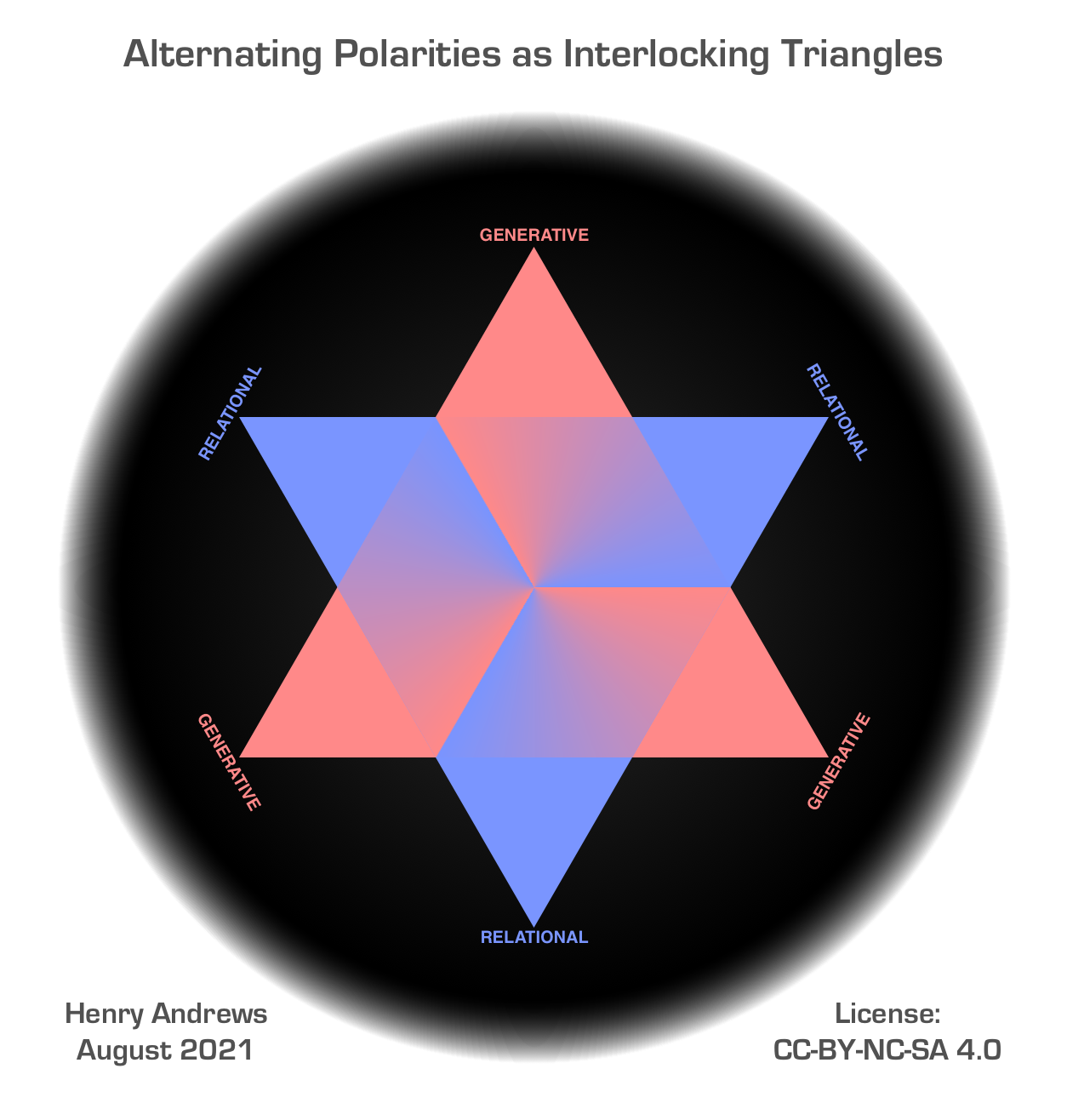
E-C Theory Existential Problems (A-F) and Systems (N-S)
Here I have simply added Graves's letters for the existential problems (life conditions) in the star's concave vertices, and his biopsychosocial system letters at the convex vertices. This is intended to suggest that the new conditions arise in response to the previous star point and motivate the emergence of the following one. Occasionally I'll do this with the pairs (AN, BO, etc.) at the convex points if I want to emphasize the overall levels, but usually I want to emphasize the emergence (the E in E-C theory!) produced by this interplay.
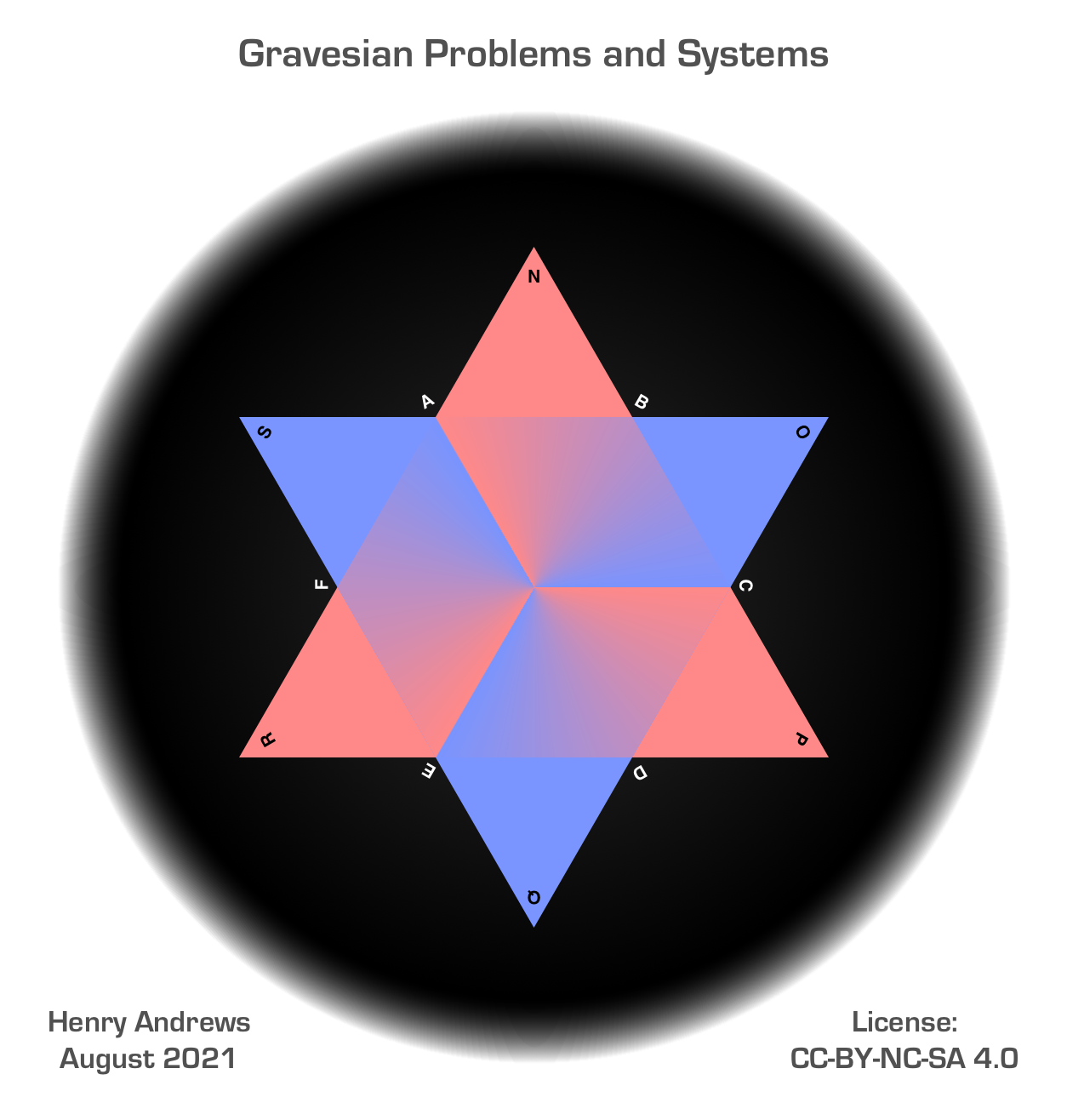
Fractal Polarities at Half-Cycle Scale
As I mentioned, the polarities are fractal, and the half-cycle alternation shown here is an overlooked implication of the theory. I need to write a full post on ideas around this, but fundamentally first half is more generative, resulting in a strong differentiation of the individual from the collective, while the second half is relational, resulting in an integration back into the collective.
I have had other folks remark that this observation resonates with them, and I need to explore it more. On the other hand, if decolonizing the theory shows that the exact clockwise sequence need not be followed, then that will raise interesting questions about how significant these patterns are, or if they generalize in some way.
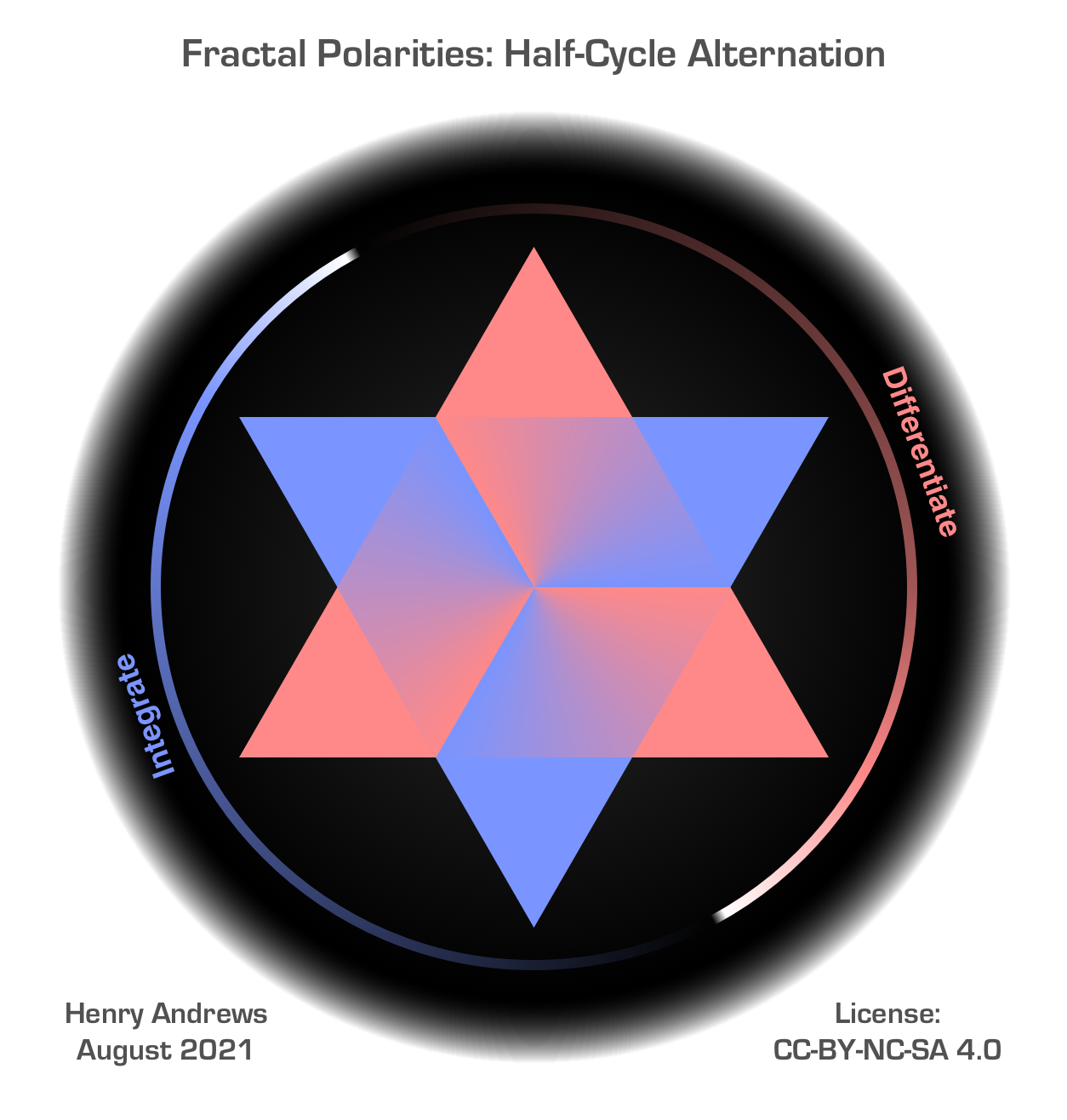
Centers of Being Connect Polarities in Opposition
A few years ago, my friend Kylie Stedman observed that there seemed to be an "every third stage" pattern of some sort. We were specifically talking about CP (Red) and FS (Green), but the pattern seemed to fit in general. I played with that idea for a while, but once I put E-C theory in this cyclical diagram, it jumped out that "every third level" was about those levels being in opposition, which indicated both conflict and complementarity.
I went through many, many, many names for these things before distilling them down to the head, heart, and gut centers of being after exploring those concepts in another context. Exploring exactly why this is the best way to think of these oppositional pairs and what that implies will be the subject of several future posts.
Notably, each half-cycle covers each center once.
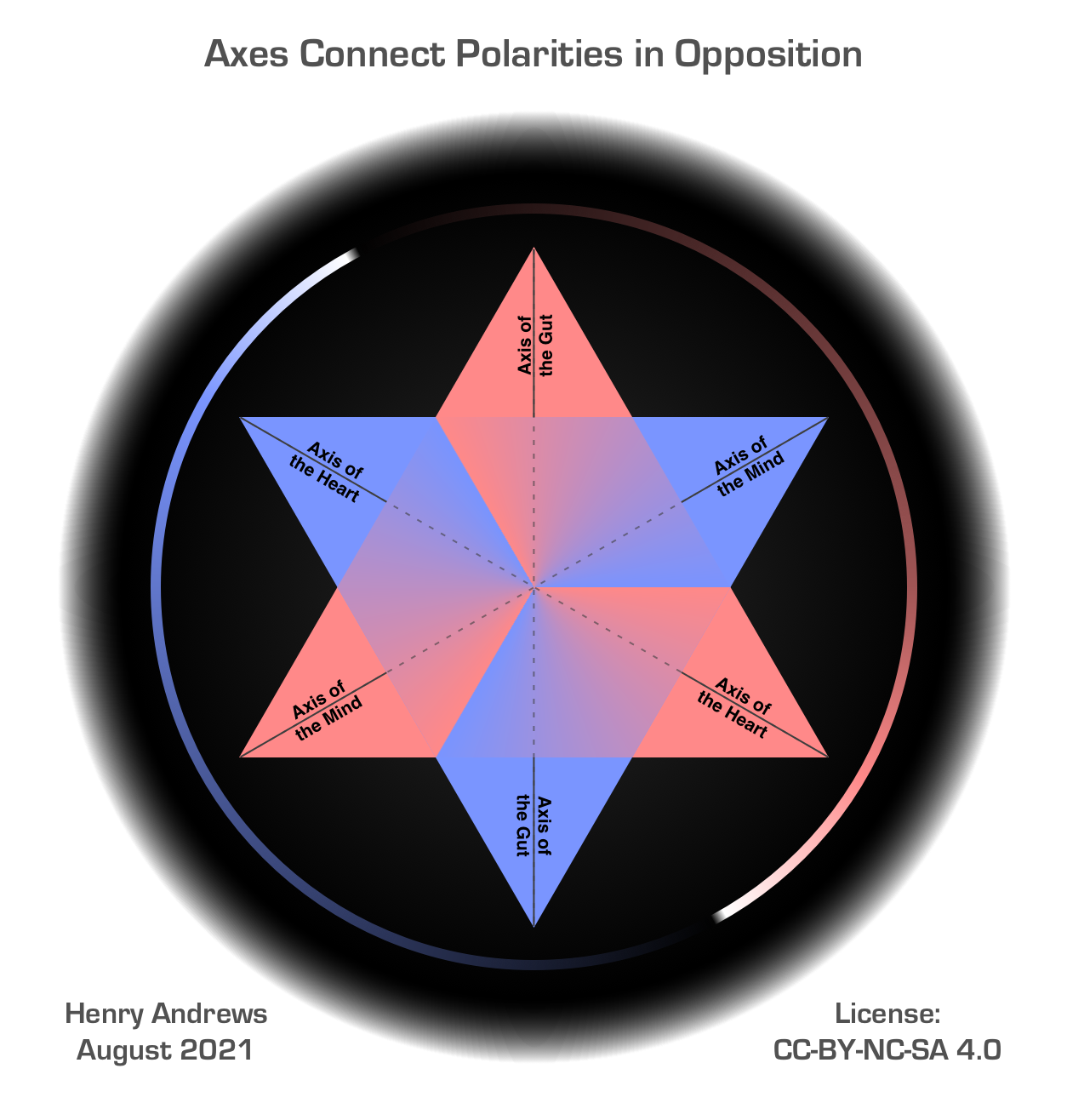
Six Ways of Being
This is, at least at the moment, my primary name for this system, and the primary set of labels I use for things. The other things labeled in this "Essential Shapes" section are still present, of course, but are assumed to be sufficiently clearly implied by the colors and positions that it is not necessary to add clutter by labeling every single thing.
While still fundamentally derived from Gravesian theory, this is now a very different frame that continues to reveal more perspectives and alternate ways to apply the underlying insights. Exploring what that means and how it relates back to E-C theory as originally presented is, of course, the primary focus of this entire site.
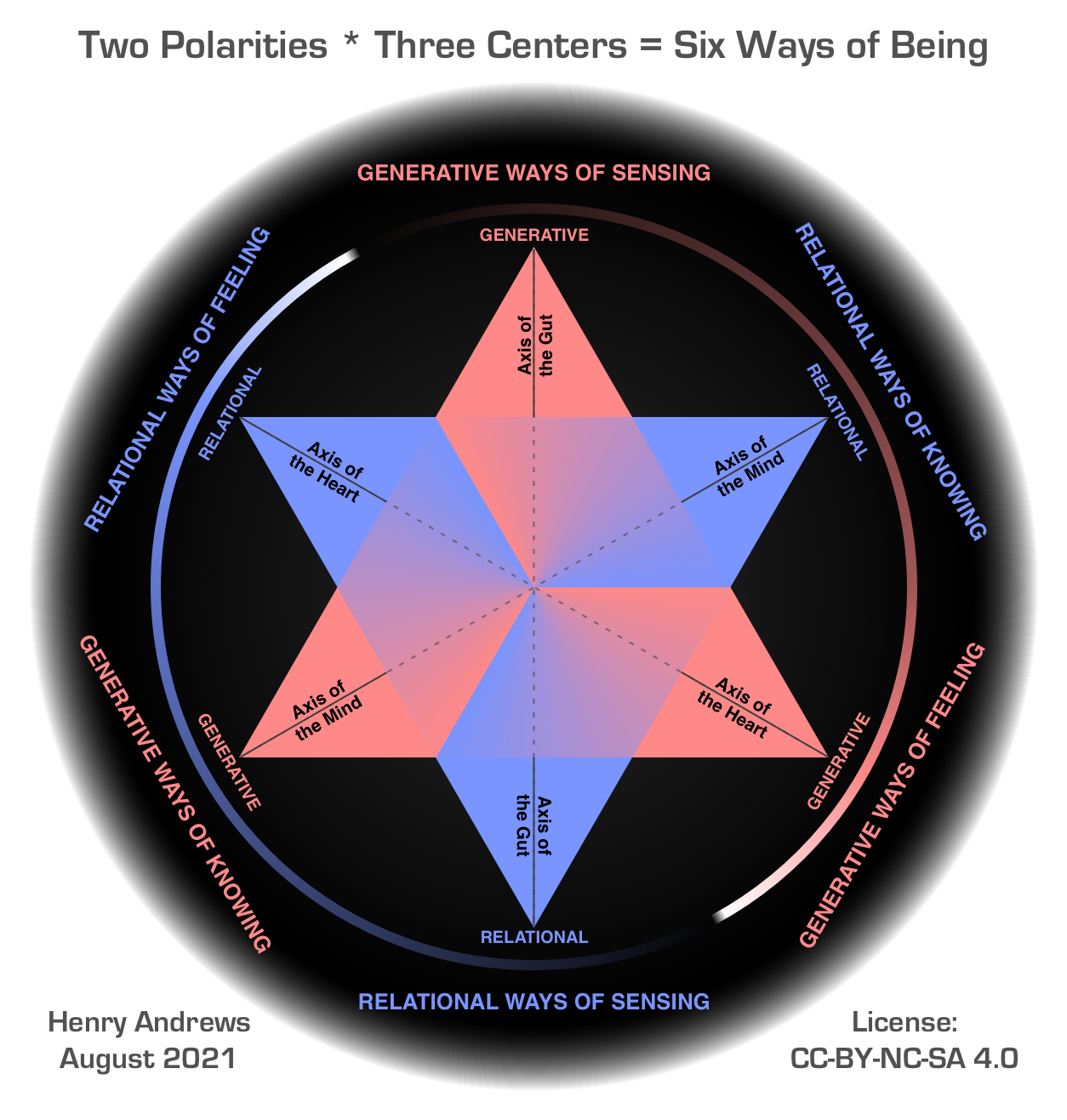
Other Systems: SD, MHC, and Cultural Codes
When posting this in online conversations, I will usually include one or more of these systems to help orient folks who often don't now the Graves letter pairs and certainly don't already know the structure of this diagram. Sometimes (as below), I also include the Graves letters.
The Beck and Cowan Spiral Dynamics colors are shown as thin arcs around the edges, with 1st tier on the inner ring, and 2nd tier (of which only the first half has been assigned colors) on the outer.
Note that I almost never do this with Wilber's AQAL altitude colors, even though many people think they are an alternate color system for Spiral Dynamics, because they are really a different thing: They are Wilber's "one ring to rule them all", his content-free (his term) labels that he correlates with everything else to provide a metric of progress across them. Speaking of "colonial as hell", one of my critiques of Wilber is that he is so focused on tying everything together that he loses the critically important subtleties of the constituent systems. For example, I could only put up to the Turquoise altitude on here anyway, because Wilber's "3rd tier" has nothing whatsoever to do with Graves. It is (very loosely, I gather) derived from the work of Sri Aurobindo.
(I should acknowledge that I'm being a bit unfair to Wilber, whose work covers a lot more ground than one rainbow on a chart, and that the AQAL charts that others have put together are themselves reductive maps of Wilber's work. Plus, he developed most of this long before our current notion of "decolonization." One day I'll discuss Integral more thoroughly, just know that I'm not trying to demonize Wilber here even if some of his choices and ideas, especially "mean green meme", irk me.)
On the other hand while Hanzi Freinacht has some sharply critical words about Spiral Dynamics, he also acknowledges that Graves found an important pattern. He uses that pattern, with the names shown here around the outer edge, as the "cultural code" component of his four-part developmental model. Sometimes I add a Turquoise-colored "Hellametamodern" label, but a.) that's a joke that is primarily hilarious to me and people I did an art project with a few years ago, and b.) since Hanzi's all "Death to Turquoise!" I figured I'd go with his actual model on this image and leave off the extra label.
A second part of that model is Michael Commons's Model of Hierarchical Complexity, which Hanzi aligns with Gravesian theory starting at MHC 7 for AN (SD Beige) and proceeding in parallel from there. This results in MHC 13 pairing with A'N' (SD Yellow), and while the MHC continues past that, in a social media discussion in June 2020 Hanzi responded to me asking about further correlation with the following:
As for higher yet value memes in SD, turquoise, coral, and so on, I think the developmental stages "break down" as a theory around this point, in other words we break out of the theory's "range"... which is normal, it even happens in physics, let alone sociology.
Particularly, there are properties about "the paradigmatic stage" that, in my mind, makes it appear very different -- it's fractal-based. And cross-paradigmatic is the "centering of all possible fractals", i.e. of all possible meaning-making and truth-claim systems, centered around the "zero", around an impossibility or central paradox. (The Mandelbrot set is not just a fractal, it's a map of all possible Julia sets, which are fractals, hence corresponding to cross-paradigmatic.)
Part of what I'm exploring here on this site is that I think the patterns Graves found and their implications for us personally and culturally are far more fractal in nature than is generally recognized, so I look forward to digging into this supposed breakdown. On the other hand, while I don't discount the existence of B'O' entirely, I do explore some aspects of agreement with Hanzi's dismissal of it as a matter of immediate practical concern near the end of a recent talk I gave.
The diagram here indicates the MHC as a step function for ratcheting up the complexity from stage to stage, including wrapping around to the next octave (a.k.a. SD "tier"). More recently, I suspect that there is more continuity, and some different structures across octaves, than this implies. And finally, the presence of six MHC stages before AN implies a lower octave, an idea that first occurred to me in the summer of 2018, a year and a half before encountering Hanzi or the MHC, and which deserves its own post.
Finally, Hanzi uses the same Cultural Code names for his "Effective Value Meme" (EVM) concept, which is kind of a measure of the aggregate or average effect of the four components of his model, which can vary at least somewhat independently. I confess to liking this idea but still finding it a bit murky. It feels a bit like the AQAL altitudes in trying to unify things, but with a more reasonable scope. I need to dig into it more, TBH.
But to put this all on one diagram:
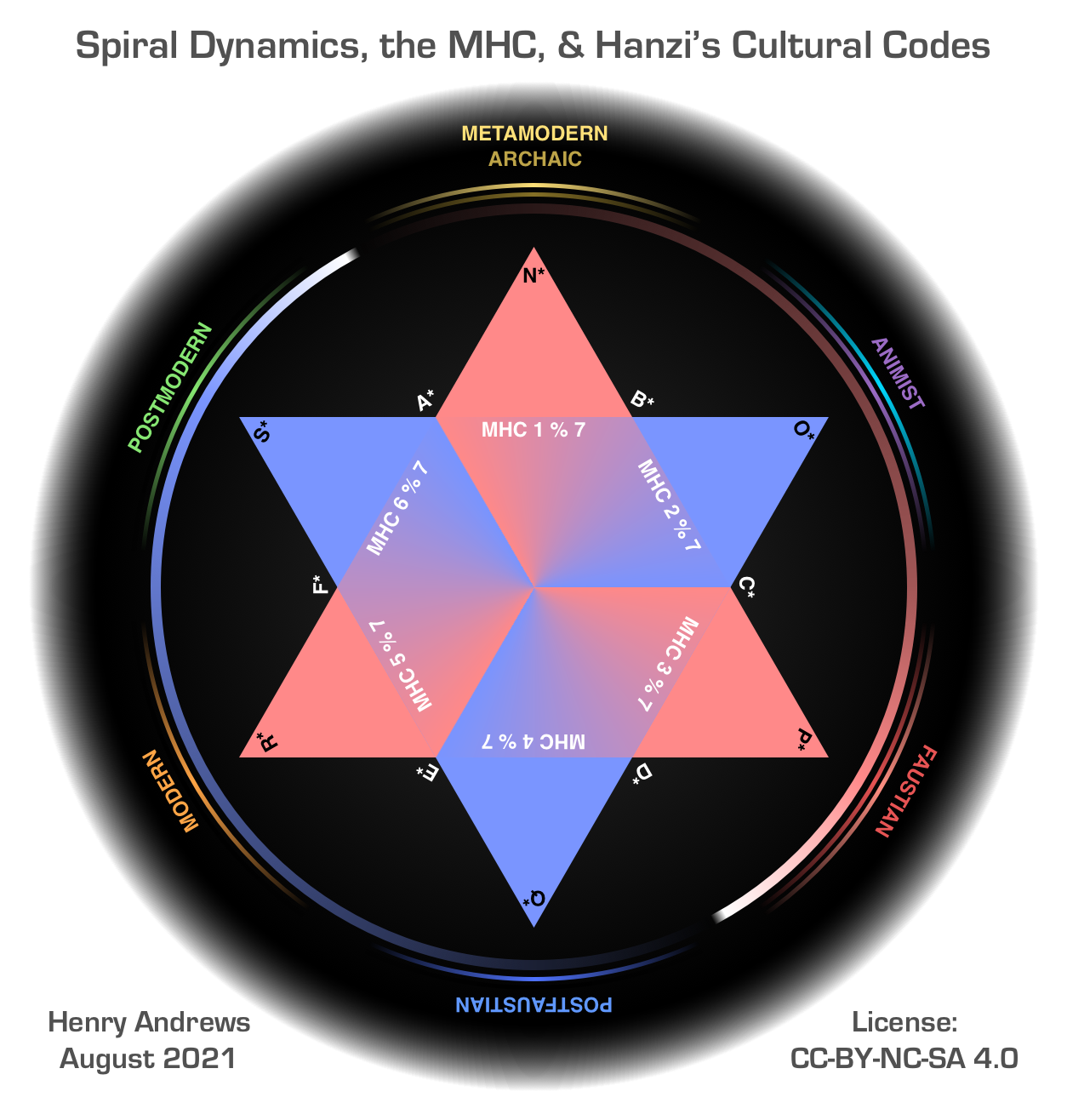
This version has all text facing inwards, emphasizing that while these other theories I have mapped to the diagram incorporate a more or less linear sense of progression, my system does not. The part that is inescapably linear is the MHC, so it is notated with modular arithmetic.
Technically the unadorned Gravesian letters refer specifically to the first six levels, so here I used my A*, B*... N*, O*... notation to indicate that these are the patterns that include both the unadorned (A) and prime (A') as well as any other manifestations of the same pattern. But generally, when plotted on this cyclical diagram, the letters always refer to the patterns even if I don't add the *s.
Decolonization
In this section, I will keep track of diagrams that I create in the process of thinking about decolonization. Not all of these variations will end up sticking, so don't be surprised if something appears here but disappears later.
The initial response
In my first comment exchange with Nora, she observed that head, heart, and gut centers aren't truly separate. This led me to add "intuition" in the middle as an idea for indicating how they can function as a whole without a clear breakdown of which center is doing what. I'm not sure that's quite the right way to indicate this, but it was a way of making a visual note of the idea to further explore later. I still haven't made up my mind on it, but new elements often go through many iterations before something settles.
Sometime later, the further discussion of pervasive cultural context led me to take my movement away from the culturally loaded "express-self" and "sacrifice-self" (a topic on which I will do a post at some point) even further, into abstract graph theory. This takes things out of the human frame entirely, yet can be mapped back to individualistic express-self (node-oriented, nodes are sometimes also called vertices) and collectivistic sacrifice-self (edge-oriented, where edges are the pairwise connections between nodes, although in hypergraphs they can be generalized to more complex multi-node connections).
I think the graph theory node/edge frame is useful, although I will probably not use it by default as it is not intuitive to everyone. But it is useful for un-sticking cultural assumptions, and developing abstract terminology for all of this might be an interesting exercise. As with the addition of "intuition", this line of thinking has not settled yet.
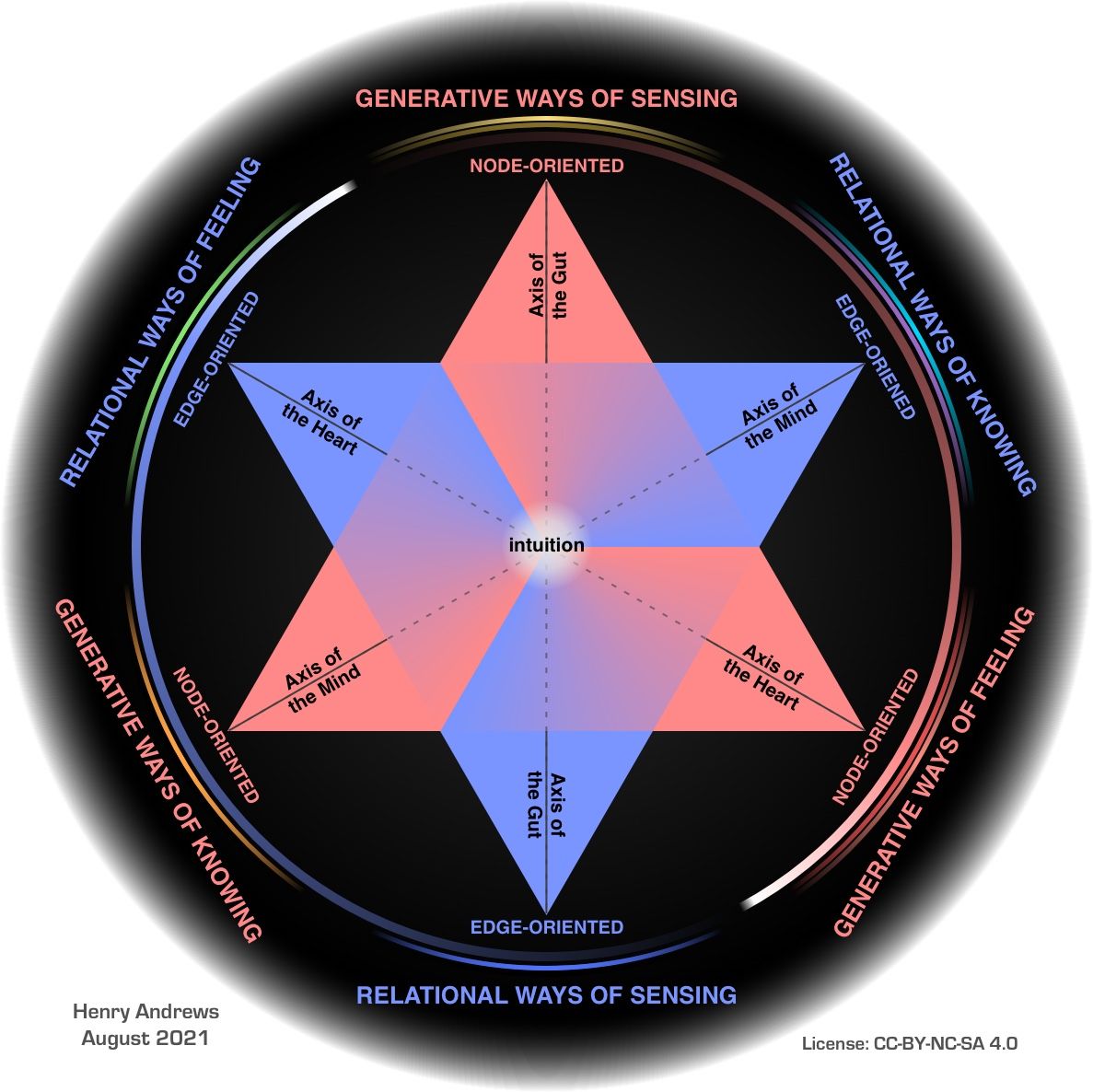
"Radical Action (to Unseat the Hold of Monkey Mind)"
King Crimson aficionados will recognize this section's title as a phrase Robert Fripp used to title both an instrumental and a live album. It refers to doing something to throw off expectations and cause the mind to engage fully with what is actually present. In Fripp's case, a year prior to writing the instrumental, he had re-formed the band with three drummers positioned across the front of the stage, with the other four or five members (it varied), including the singer, more-or-less stationary on a riser behind them. No other rock band looks like that. It meant that the band could play older material but make it new, rather than being a nostalgia act.
Decolonizing something requires seriously unseating some assumptions, so how could I do that with this diagram I've spent over a year working with?
Three parts of the "colonial bullshit" debate motivated me to create this image by applying the maximum Gaussian blur (well, maximum supported by Sketch, the program I use for these diagrams) to the "initial response" image above, minus the words:
- Following up on the node-oriented / edge-oriented frame, I realized how node-oriented the theory is, and how my diagram reflects that in its sharp edges and precise geometry. Nodes relate to each other here through precise positioning and straight lines or perfect arcs of a circle. In contrast, the different "minds" discussed in Tyson Yunkaporta's Sand Talk are all highly relational (edge-oriented).
I asked myself, what would happen if the nodes were treated more as attractors (as Gravesian theory / SD actually specifies, although that is often forgotten), and emphasis was put on the nature of the space between them? I was thinking about how to represent attenuating, overlapped fields. I didn't get too far with this before deciding I needed to think more about relational systems first. But that led to: - The idea of "what happens if you take Spiral Dynamics and remove any boundaries around the levels?" Setting aside that technically SD does not have sharp boundaries (because in practice, a lot of people act like it does and visualize it that way), what if there were no clear boundaries or connections in my diagram?
- Nora's post about letting a model "be a distant dream that cannot be spoken into a morning's kiss" inspired me to think of how my diagram would look as such a dream. Something you can't quite resolve, and if you try too hard you wake up and lose it entirely. Or after you wake up, your brain will fill in details until you're remembering your reconstruction rather than the dream experience. It was an evocative challenge to release the need for precise control. As Nora wrote in a Medium piece: "Warm Data does not offer measurements, but rather a look in the rearview mirror at the hunger to control."
So I realized Sketch made it easy for me to blur all the things! At first I did a less drastic one, but it was still possible to make out the shapes even if you didn't know what they were in advance. So I maxed it out and got this beautiful blur. So dreamy! If you don't know what's there you'll have a hard time being certain what it is. You'll get close, but you might interpret the thing in the middle as a hexagon or a circle rather than a star, depending on how you think it's blurring into the elements around it.
In truth, I also fiddled with some of the visual components' relative sizes and scales in order to get all of the elements to show up to some degree in an aesthetically pleasing way, so if you un-blurred this it would not look the same as above. But dreams are not exact, and applying a rigidly mechanical transformation would not really be unseating much. This image became the banner for the site because it really expresses where I am right now: continuing to use this approach as my guide, but trying to avoid being too attached to its exact current details.

Applications
The "regular" form and coloring of the diagram is great for packing a lot of theory inside a contained space. But my expectations is that applications of this work will avoid looking too much like a developmental theory.
Ritual for co-exploration of challenging topics
This version of the diagram incorporates additions and changes drawn by Kaa Faensen when we gave the idea of this ritual its first run-through. We've never talked in detail about her design choices, so the interpretations here are mine.
Symbolically, it feels more open and even more in motion with the spiral tracing the path around the symbol (for some reason, this one feels more like a "symbol" than a "diagram"). And perhaps even more importantly, extending the axes outside of the main circle opens up more space inside (by moving the axis labels) and gives this version the feeling of being anchored in the wider world. The axes fade out, attaching somewhere outside of our field of view. They even give a hint of a feel of the symbol being caught in a spider-web, which I find fascinating.
